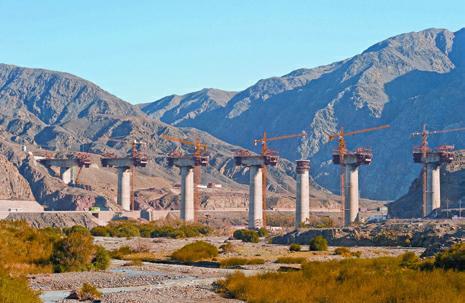Increased Infrastructure in Western China Creates a New Engine for Development
Increased Infrastructure in Western China Creates a New Engine for Development
In the first quarter, the import and export volume of Chinas central and western regions reached RMB 1.5 trillion, representing a year-on-year increase of 45.1 percent, 15.9 percentage points higher than the overall growth rate of Chinas foreign trade, according to data from the General Administration of Customs.
The west is becoming a new engine for the countrys economic growth. The Sichuan-Chongqing area, with a population of 120 million and an economic aggregate of nearly RMB 7 trillion, is expected to be a driving force for national high-quality development.
Chinas vast western regions once had the weakest infrastructure in the country. Statistics show that by the end of 2000, the number of townships and villages without access to highways in the west accounted for 94 and 57.6 percent of the nations total respectively. Highways there were often damaged or blocked, and traffic accidents were frequent.
Thanks to Chinas Western Development Strategy launched in 2000, infrastructure development in the regions has undergone earth-shaking changes. Sichuans total highway length led the country by the end of 2020, reaching 347,000 kilometers. All townships and villages now have paved roads. In addition, an international aviation hub has also been created, making the western region a market with the biggest potential in China for domestic consumption.
Chinas Exports of Home Appliances Boom
In the first quarter of this year, Chinas exports of household appliances totaled RMB 147.94 billion (US $22.9 billion), an increase of 63.4 percent year on year, according to statistics from the General Administration of Customs.
Major home appliance manufacturers from China such as GREE, Midea, Hisense, and TCL are all scrambling to expand their overseas influence by making their presence felt at globally renowned stadiums. At the same time, they are also seeking to integrate into a larger international market by joining hands with internationally influential athletes.
Through customized strategies and acquisition, they are entering local markets much more quickly. At present, with intelligent and digitalized products, they are gaining more and more influence in the high-end market globally.
Opportunities come together with challenges. Faced with such challenges as global supply chain fluctuations and trade barriers, Chinese enterprises need to, on the one hand, accelerate the building of overseas independent brands, and on the other hand, innovate marketing models. Compared with the traditional foreign trade model featuring high costs and many procedures, cross-border e-commerce provides a new channel with higher efficiency and lower costs for Chinese home appliance brands to go global.
Tech Innovation Key to Carbon Neutrality in Chinas Paper-Making Industry
Chinas paper-making industry is among the first eight sectors included in carbon trading in the country. According to data released by the China Paper Association (CPA), at present, per capita paper consumption in China is only about half of that in developed countries. It is estimated that by 2035, the figure will stand between 120 kilograms and 130 kilograms, while the supply volume still needs to be increased by 50 million to 70 million tons prior to 2035.
Currently, Chinas paper-making industry mainly relies on the heat generated by coal, natural gas, and other fossil fuel energy for pulp and paper production. Fossil fuel accounts for about 80 percent of the purchased energy, while biomass energy accounts for less than 20 percent of the total. To achieve carbon peak and carbon neutrality goals, the industry needs to optimize its energy structure and promote green development.
Zhao Wei, secretary general of the CPA, pointed out that the sector needs to redouble its efforts, especially in terms of technology innovation and seeking alternative energies.
Some paper manufacturers have already taken actions. They are gradually replacing fossil fuels such as coal with biomass energy, improving the reuse rate of water, and reducing water consumption through technological innovation and equipment improvement.

